Introduction
A well-made pesto pasta recipe is more than just a meal—it’s an experience. The moment you take a bite, you’re greeted with the freshness of basil, the nutty richness of Parmesan, and the smooth silkiness of olive oil, all perfectly coating tender pasta. Whether you’re looking for a quick weeknight dinner or a dish that impresses guests, this pesto pasta recipe will never let you down.
In this guide, we’ll walk you through a step-by-step process to make the most delicious pesto pasta recipe from scratch. You’ll also learn expert tips, creative variations, and the most common mistakes to avoid. By the time you finish reading, you’ll be ready to create a restaurant-quality dish that will have everyone asking for seconds.
What Makes This the Best Pesto Pasta Recipe?
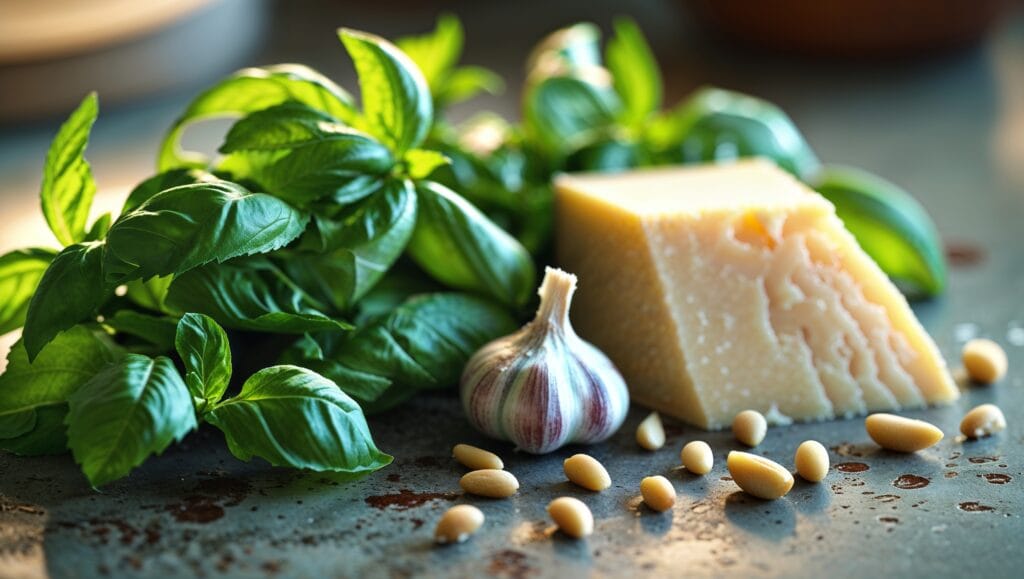
The beauty of pesto pasta lies in its simplicity. But not all pesto pasta dishes are created equal. The secret to making an outstanding pesto pasta recipe comes down to three key factors:
- Fresh Ingredients: Using high-quality, fresh basil, garlic, Parmesan, and pine nuts makes a world of difference. When ingredients are fresh, they enhance the overall flavor, creating a more aromatic and authentic taste.
- Perfect Pasta Texture: Cooking pasta al dente ensures it holds up well and absorbs the flavors beautifully. Overcooked pasta can become mushy and won’t provide the right bite, while undercooked pasta won’t hold onto the sauce properly.
- A Smooth and Balanced Sauce: A good pesto sauce isn’t too oily or too dry—it’s just right. The key is to blend the ingredients at the right speed and consistency, ensuring the flavors meld together in perfect harmony.
With these elements in mind, let’s look at how to make the best pesto pasta recipe at home.
Ingredients You’ll Need
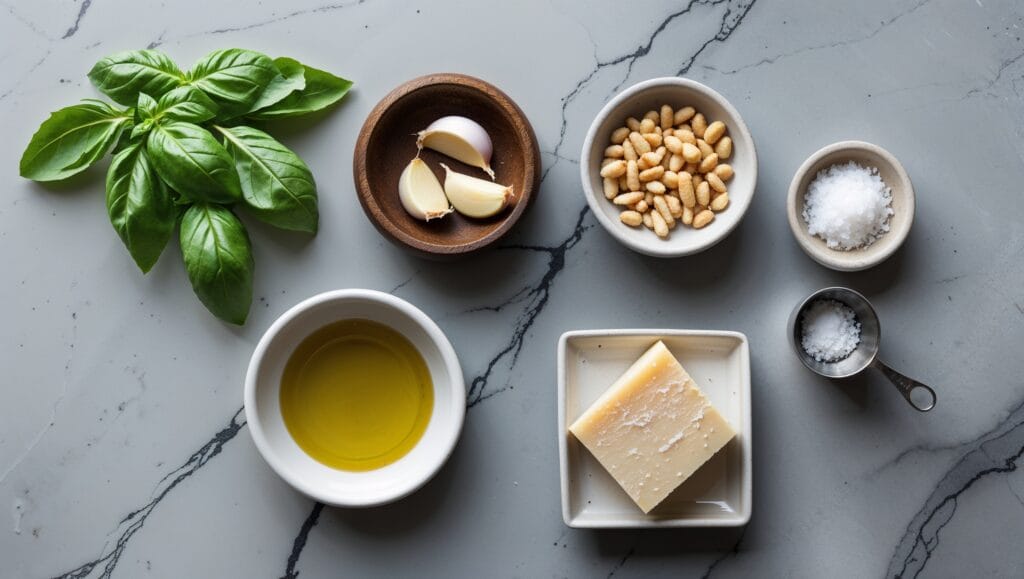
To make a traditional pesto pasta recipe, gather the following ingredients:
For the Pesto Sauce:
- 2 cups fresh basil leaves (packed)
- ½ cup grated Parmesan cheese
- ⅓ cup pine nuts (or walnuts for a budget-friendly option)
- 2 cloves garlic
- ½ cup extra-virgin olive oil
- ½ teaspoon salt
- ¼ teaspoon black pepper
- Juice of ½ lemon (for freshness)
For the Pasta:
- 12 oz pasta (spaghetti, penne, or fusilli work best)
- ½ cup reserved pasta water
- 1 tbsp olive oil
Each ingredient plays a crucial role in the dish’s overall taste and texture. Fresh basil provides the signature herby flavor, Parmesan adds a salty, nutty depth, and olive oil brings everything together with a smooth, velvety finish. Using high-quality ingredients is the secret to making your pesto pasta recipe stand out.
Step-by-Step Guide to Making Pesto Pasta
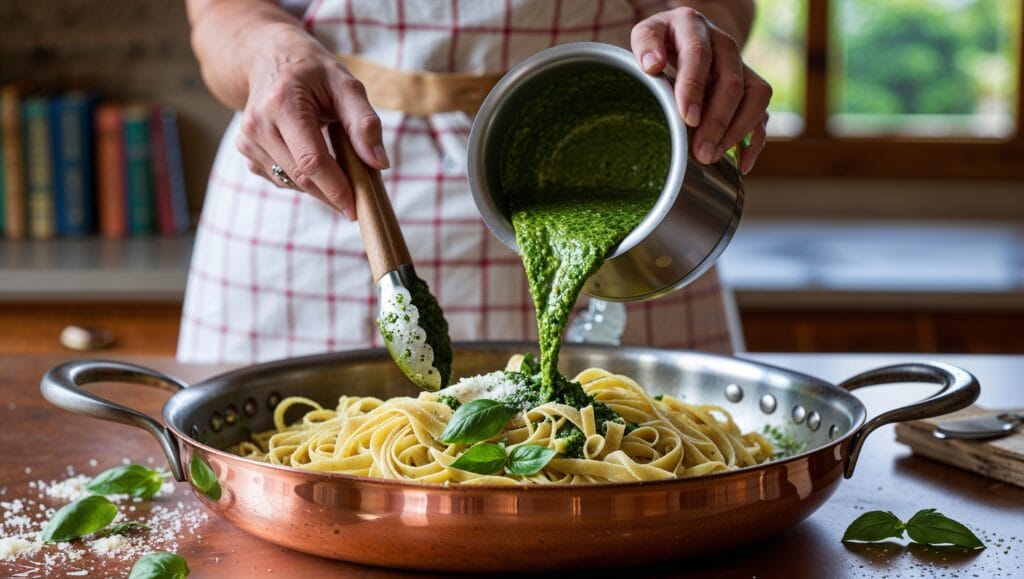
Step 1: Cook the Pasta to Perfection
Bring a large pot of salted water to a boil. Add the pasta and cook according to the package instructions until al dente—firm to the bite. Before draining, reserve ½ cup of pasta water, then drain and set the pasta aside. This starchy water will help the sauce adhere to the pasta better, creating a silky-smooth consistency.
Adding salt to the pasta water is an essential step—it enhances the pasta’s natural flavor, preventing the dish from tasting bland. For best results, use about 1 tablespoon of salt per 4 cups of water. Once the pasta is cooked, avoid rinsing it under cold water, as this removes the starch that helps bind the sauce.
Step 2: Make the Pesto Sauce
In a food processor or blender, combine basil, garlic, Parmesan, and pine nuts. Pulse a few times until coarsely chopped. Slowly drizzle in the olive oil while blending, ensuring a smooth, creamy consistency. Finally, add lemon juice, salt, and black pepper, and blend once more.
If you prefer a chunkier pesto, pulse the mixture lightly and avoid over-blending. The lemon juice helps maintain the bright green color of the basil and balances the richness of the oil and cheese. Be sure to taste the pesto and adjust the seasoning to your preference before mixing it with the pasta.
Step 3: Combine Pasta and Pesto
Return the drained pasta to the pot while it’s still warm. Add the fresh pesto and a little reserved pasta water, tossing until the pasta is evenly coated. The heat from the pasta helps release the flavors of the pesto, making the dish even more aromatic.
Using pasta water is a trick many professional chefs swear by—it creates a glossy sauce that clings beautifully to the noodles. If the pesto looks too thick, add a little more pasta water and toss until it reaches the desired consistency.
Step 4: Serve and Enjoy
Garnish with extra Parmesan cheese, toasted pine nuts, and a drizzle of olive oil. Serve immediately and enjoy every bite! If you’re looking for an extra layer of flavor, sprinkle some red pepper flakes for a subtle kick or add a handful of fresh cherry tomatoes for a sweet, juicy contrast.
This pesto pasta recipe is best enjoyed fresh, but it can also be stored in the refrigerator for up to three days. Simply reheat it gently over low heat and add a splash of olive oil to refresh the sauce.
Expert Tips for the Perfect Pesto Pasta
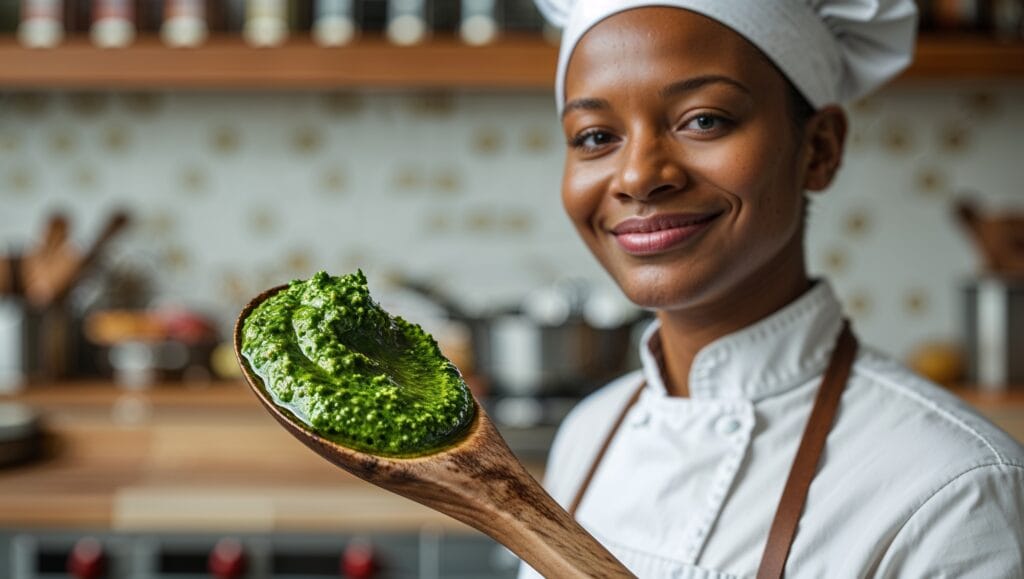
✅ Use Fresh Basil – The fresher the basil, the more vibrant your pesto will taste. Older basil can have a bitter flavor, so always choose bright green leaves.
✅ Toast the Pine Nuts – Lightly toasting pine nuts enhances their nutty flavor, making your pesto even richer. A quick toast in a dry pan over medium heat for 2-3 minutes is all it takes.
✅ Don’t Overheat the Pesto – Heat can dull the fresh flavors of pesto, so always mix it with warm pasta off the heat. Pesto should never be cooked directly in a pan.
✅ Balance the Texture – If your pesto is too thick, add a splash of pasta water. If it’s too thin, blend in more Parmesan or nuts. Adjusting the consistency ensures the perfect bite every time.
✅ Make It in Advance – Pesto can be stored in an airtight container in the fridge for up to 3 days or frozen for 3 months. To keep the color fresh, drizzle a thin layer of olive oil on top before storing.
Final Thoughts: Make the Best Pesto Pasta Recipe Today!
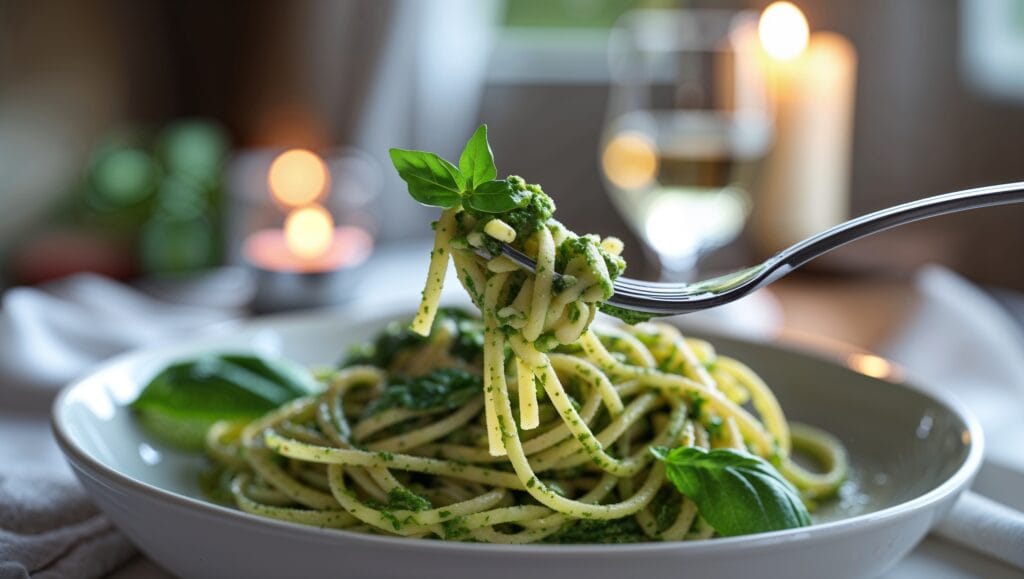
Now that you know how to make the ultimate pesto pasta recipe, it’s time to put these tips to the test. Whether you go for the classic version, a creamy twist, or a chicken pesto pasta recipe, you’re in for a delicious meal that’s fresh, flavorful, and satisfying.
For more inspiration, you can check out this guide on pesto variations to explore different flavors and unique combinations.
Making your own pesto from scratch is not only easy but also rewarding. The vibrant flavors, the silky texture, and the perfect balance of ingredients come together to create an unforgettable dish. Plus, once you’ve mastered this pesto pasta recipe, you can start experimenting with different variations to find your own signature twist.
🔥 Try it out today and share your favorite variation in the comments below!
- 10 Best Breakfast Sausage Recipes for a Perfect Homemade Meal
- 10 Irresistible Ricotta Cheese Recipes You’ll Absolutely Love
- Tom Collins Recipe: 5 Easy Steps to Make the Perfect Cocktail
- Martini Recipe: 7 Secrets to Crafting the Perfect Cocktail
- 🎂 5-Step Dog Cake Recipe: A Healthy & Delicious Treat for Your Pup



